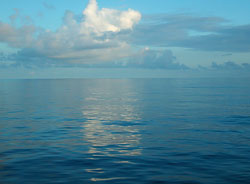

 | |||||||||||
|
|
Journals 2008/2009Cheryl Manning
January 18, 2009 This morning I went up to the "steel beach," a deck that is above the bridge and watched the water and horizon. From very far away, I could see something in the water. It was either a sea turtle sunning itself or a bag of garbage. It got me thinking: 43 days, 51 people, what would you do with all the trash that is created in this situation? On board the R/V Knorr, I have the opportunity to work with Dennis Graham. Dennis has been working as a scientist aboard ships since 1971. I asked him how trash has been dealt with in that time. Back in the early 70's people didn't think anything of throwing everything overboard into the ocean. As people's attitude towards trash and pollution changed, so did the methods of disposing of it.
Plastic is the biggest problem. It is derived from petroleum, floats, and decomposes very slowly. In the mid-70's into the 80's ship stewards on science ships stopped throwing it into the ocean. Instead, they would put all the trash into a big metal basket, put the basket on a crane, pour some gasoline on it and burn it. The ash and debris remaining would then be dumped into the water. Not great, but better. On many ships, there are very high temperature incinerators. When trash is put in these, there is nothing left but a little ash, which can be carried to the next port. Many ships, including the R/V Knorr don't have an incinerator. Instead they follow the guidelines outlined by the International Treaty, Annex V-MARPOL, which makes it illegal to dump plastics into the ocean. Why plastics? Well, they are the biggest problem. In 1975, the National Academy of Science estimated that 14 billion pounds of garbage was dumped into the ocean every year. 85% of this came from merchant ships. The U.S. fleet was responsible for about 1/3 of the trash in the ocean. Plastic, Styrofoam and other synthetic fibers are the most damaging materials because they float and look like other things: a plastic grocery bag resembles a jellyfish to a sea turtle, brightly colored small pieces of plastic look like fish eggs to seabirds, and nylon nets entrap seals and other marine animals. The plastic ring that holds a 6-pack of soda can last 400 years. So, a little plastic goes a long way. So what do we do on the R/V Knorr? We do not produce a lot of garbage. We do not use much that is disposable. There is very little packaging. There are no paper cups or disposable utensils. The scientific endeavor creates the most garbage so it must be dealt with appropriately. When there isn't a lot of room on board a ship to begin with, this is a challenge.
All metal, glass, and biodegradable garbage are separated out from anything containing plastic. If the plastic had food in it, it is rinsed. Every bit of plastic trash is stored on board the ship in a shipping container: tape, wire coating, bags, dental floss, anything with any plastic. The rest, well, as hard as it was for me to watch, is thrown over board in big paper bags. This is what the International Treaty, Annex V-MARPOL dictates. The bags only last for a day or so, the kitchen scraps are eaten by the fish, and what ever is left falls to the bottom. Remember, glass is just silica (quartz) and metal is just metal: they all came from mineral resources in the first place. But, the efforts don't end here. According to my research, much is being done to make all scientific vessels entirely sustainable. Nothing would be thrown overboard. This would involve incineration, storage and minimizing the use of anything that could end up getting thrown away. Until all ships are better equipped to deal with trash, the practice of throwing biodegradables and mineral resources overboard will be inevitable.
Questions:
|
||||||||||

